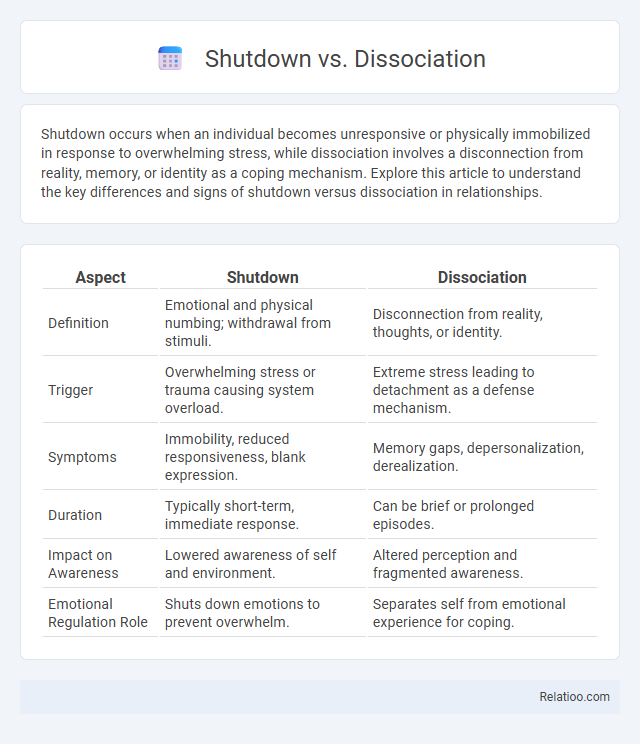Shutdown occurs when an individual becomes unresponsive or physically immobilized in response to overwhelming stress, while dissociation involves a disconnection from reality, memory, or identity as a coping mechanism. Explore this article to understand the key differences and signs of shutdown versus dissociation in relationships.
Table of Comparison
| Aspect | Shutdown | Dissociation |
|---|---|---|
| Definition | Emotional and physical numbing; withdrawal from stimuli. | Disconnection from reality, thoughts, or identity. |
| Trigger | Overwhelming stress or trauma causing system overload. | Extreme stress leading to detachment as a defense mechanism. |
| Symptoms | Immobility, reduced responsiveness, blank expression. | Memory gaps, depersonalization, derealization. |
| Duration | Typically short-term, immediate response. | Can be brief or prolonged episodes. |
| Impact on Awareness | Lowered awareness of self and environment. | Altered perception and fragmented awareness. |
| Emotional Regulation Role | Shuts down emotions to prevent overwhelm. | Separates self from emotional experience for coping. |
Understanding Shutdown and Dissociation
Shutdown and dissociation are distinct psychological responses to overwhelming stress, with shutdown involving a physical or mental numbness and decreased responsiveness, while dissociation refers to a disconnection from reality or a fragmented sense of self. Understanding shutdown helps you recognize symptoms like freezing, reduced sensory awareness, and withdrawal, which serve as survival mechanisms during extreme emotional distress. Recognizing these signs aids in managing trauma responses and seeking appropriate therapeutic support to restore emotional regulation and grounding.
Key Differences Between Shutdown and Dissociation
Shutdown involves a complete or partial loss of response to stimuli, often triggered by overwhelming stress, causing the body to enter a protective mode, whereas dissociation refers to a disconnection between thoughts, identity, consciousness, or memory, creating a sense of unreality or detachment. You may experience shutdown as physical immobility or muteness, while dissociation manifests as feeling detached from yourself or your surroundings. Understanding these key differences helps in accurately identifying your symptoms and seeking appropriate care.
The Science Behind Shutdown Responses
Shutdown responses originate from the autonomic nervous system's attempt to protect the body during extreme stress by reducing sensory input and metabolic activity, often linked to the parasympathetic nervous system activation. Dissociation, a psychological defense mechanism, disconnects awareness from reality to escape traumatic experiences, involving alterations in brain regions such as the prefrontal cortex and amygdala. Shutdown merges physiological and psychological elements, resulting in decreased responsiveness and mental disengagement driven by neurobiological stress pathways and hormonal changes like cortisol release.
What Triggers Dissociation?
Dissociation is primarily triggered by intense stress or traumatic experiences that overwhelm Your ability to cope, leading the mind to detach from reality as a defense mechanism. Unlike shutdown, which results from sensory overload causing a physical or emotional freezing, dissociation involves a disconnection from thoughts, feelings, or surroundings to protect against psychological pain. Understanding these triggers helps differentiate dissociation from shutdown and informs effective strategies for emotional regulation.
Symptoms of Shutdown vs Dissociation
Shutdown symptoms typically include physical immobility, decreased responsiveness, and a profound sense of numbness, often as a response to overwhelming stress or trauma. Dissociation symptoms involve a disconnection from reality, memory lapses, altered perception of time, and feelings of detachment from oneself or the environment. Understanding these differences helps you identify specific responses and seek appropriate support for each condition.
Psychological Causes and Risk Factors
Shutdown, dissociation, and shutdown responses are linked to psychological trauma, stress, and anxiety, often rooted in adverse childhood experiences and chronic stress exposure. Dissociation manifests as a disconnection from reality or self, frequently triggered by overwhelming emotional distress or unresolved trauma, while shutdown refers to a freeze response where the nervous system conserves energy during perceived inescapable threat. Risk factors include a history of PTSD, complex trauma, emotional neglect, and heightened sensitivity to environmental stressors, which amplify vulnerability to these coping mechanisms.
Shutdown and Dissociation in Trauma Survivors
Shutdown in trauma survivors manifests as a complete emotional and physical immobilization, where Your body and mind enter a protective state to minimize sensory input and pain. Dissociation involves a disconnection from reality or self, often causing memory gaps, detachment, or feeling as if outside one's body. Both responses serve as coping mechanisms during overwhelming trauma but differ in their expression and psychological impact.
Impacts on Daily Functioning and Relationships
Shutdown, dissociation, and shutdown episodes each uniquely disrupt daily functioning and relationships by impairing communication and emotional responsiveness. Shutdown typically involves decreased physical and cognitive activity, limiting one's ability to engage in routine tasks and social interactions. Dissociation detaches individuals from their surroundings or sense of self, causing memory gaps and emotional numbness that strain trust and intimacy in relationships.
Strategies for Coping and Recovery
Shutdown involves a temporary state of physical and emotional numbness where Your body becomes unresponsive to overwhelming stress, while dissociation is a mental detachment from reality, creating gaps in memory or identity for coping. Strategies for recovery emphasize grounding techniques such as deep breathing exercises, sensory stimulation, and mindfulness to reconnect with the present moment and regain control. Seeking therapy, especially trauma-informed approaches like EMDR or cognitive-behavioral therapy, supports healing by addressing underlying causes and building resilience against future shutdowns or dissociative episodes.
When to Seek Professional Help
Seek professional help when shutdown or dissociation symptoms interfere with daily functioning, such as persistent memory loss, inability to communicate, or prolonged emotional numbness. Signs like recurring blackouts, increased isolation, or self-harm urges indicate the need for immediate psychological intervention. Early diagnosis and specialized therapy can effectively address underlying trauma and prevent chronic mental health issues.

Infographic: Shutdown vs Dissociation
 relatioo.com
relatioo.com